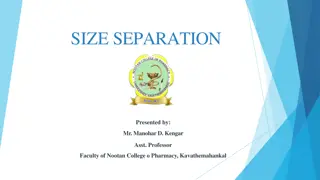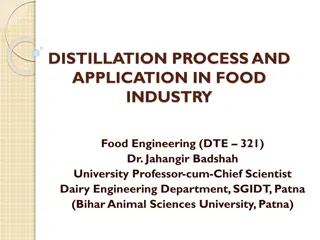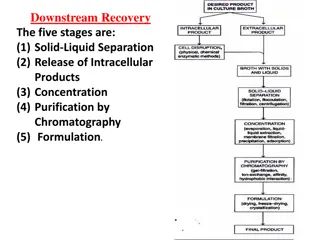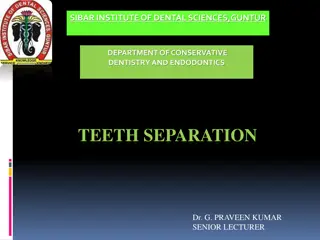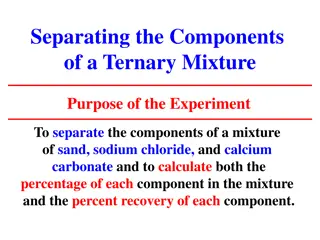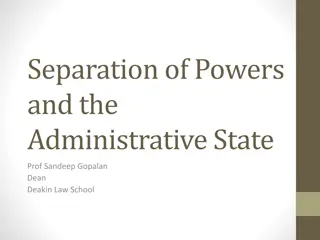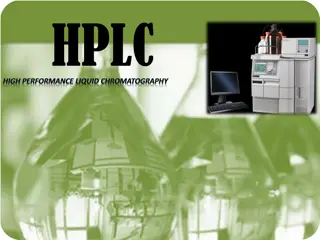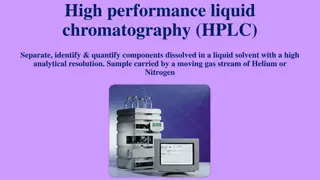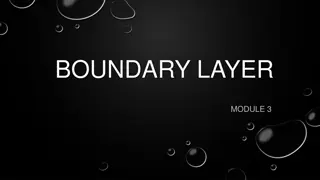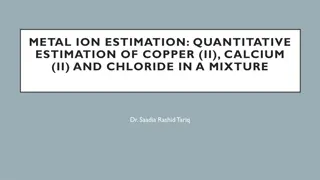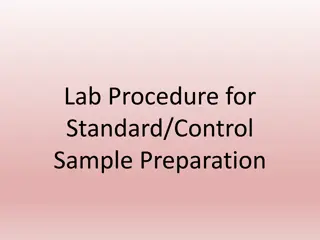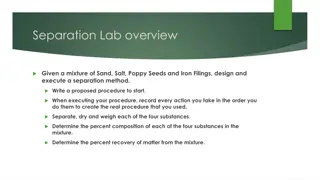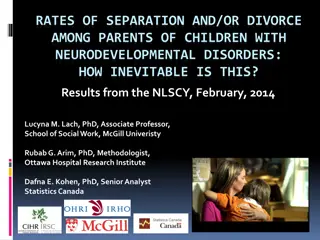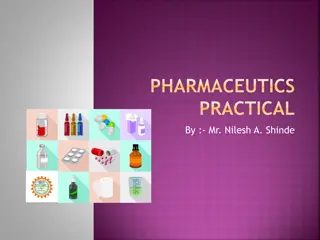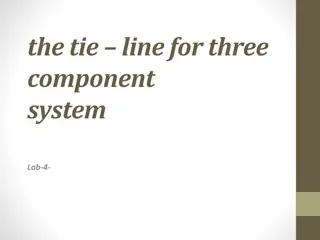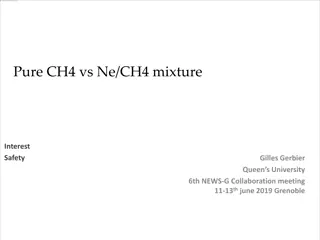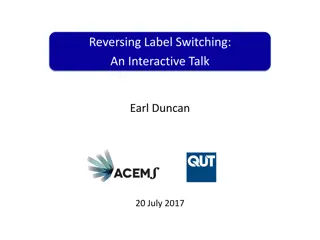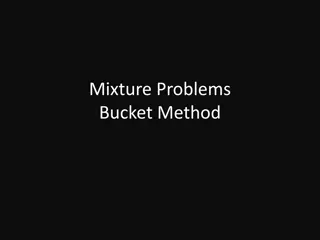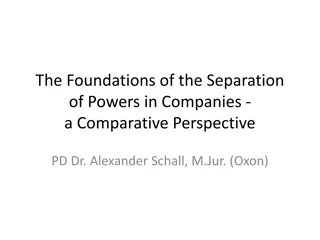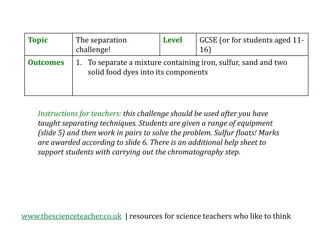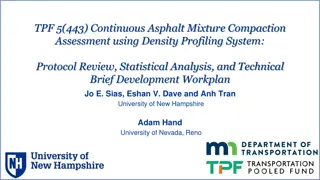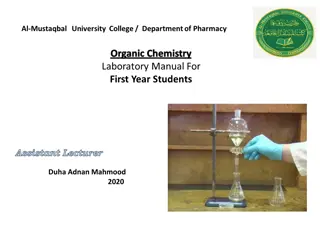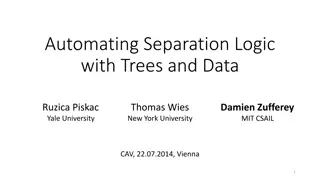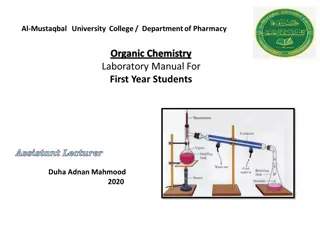Understanding Medical Separation with Reinstatement Rights (MSWR)
Explore the key elements involved in placing a student on Medical Separation with Reinstatement Rights (MSWR), including consultation with Wellness staff and recent policy changes. Delve into scenarios where MSWR might be needed and understand the process of Medical Separations in Job Corps. Gain in
2 views • 26 slides
Cannizzaro Reaction: Separation of Benzoic Acid and Benzyl Alcohol
The Cannizzaro reaction involves the separation of benzoic acid and benzyl alcohol by utilizing various reagents and procedures such as dissolving potassium benzoate, washing with ether, and treatment with different solutions to isolate the desired compounds. The process involves multiple steps incl
7 views • 4 slides
Understanding Separation Processes in Gas Production
This presentation delves into the importance of separating gases, oils, and solids in the well stream for effective field processing. It covers the theory of separation, different processes involved, types of separators, and their specific uses, such as vertical and horizontal separators. Images and
1 views • 23 slides
Understanding Mixtures and Separation Techniques
Explore the concepts of mixtures and separation, from the definition of dominant and recessive alleles to the advantages of electron microscopes. Learn about identifying pure substances, differences between pure and impure substances, and techniques like filtration and crystallization for separation
1 views • 19 slides
Understanding Size Separation in Pharmaceutical Processing
Size separation is a crucial unit operation in pharmaceutical manufacturing, involving the segregation of particles based on physical differences like size, shape, and density. This process, also known as sieving or screening, is essential for improving powder mixing, particle solubility, and stabil
1 views • 31 slides
Distillation Process and Applications in Food Industry
Distillation is a separation process used in the food industry to separate components in a mixture based on their volatility. It involves vaporization, condensation, and re-evaporation to achieve separation. Steam distillation is a method where steam is used to reduce boiling temperatures for safe s
1 views • 13 slides
Key Steps in Downstream Processing: Recovery and Separation Techniques
The downstream recovery process involves five major stages: solid-liquid separation, release of intracellular products, concentration, purification by chromatography, and formulation. Solid-liquid separation methods include flotation, flocculation, and filtration using techniques like depth filters,
0 views • 33 slides
Tooth Separation in Conservative Dentistry and Endodontics: Methods and Importance
Tooth separation is essential in restorative procedures to enhance convenience, achieve proper contacts and contours, improve operative treatment outcomes, and maintain oral health. This process involves slightly moving teeth apart or closer, or changing their spatial position. Different methods suc
1 views • 28 slides
Separating Components of Ternary Mixtures: Experiment and Methods
Experiment aims to separate sand, sodium chloride, and calcium carbonate in a mixture to calculate percentages and recovery. Explore various methods like chromatography, distillation, extraction, centrifugation, crystallization, and sublimation for component separation.
1 views • 30 slides
Principles of Separation of Powers in the Administrative State
Understanding the principles of separation of powers - including the separation of functions, division of power, checks and balances, bicameralism, and federalism - is crucial in maintaining a system where governmental entities coexist harmoniously while preventing the concentration of political pow
0 views • 20 slides
Understanding HPLC: A Powerful Liquid Chromatography Technique
High-performance liquid chromatography (HPLC) is a powerful tool in analysis, offering high performance and speed compared to traditional chromatography methods. It involves separating components through a stationary phase and mobile phase, utilizing adsorption principles for separation. HPLC is wid
6 views • 58 slides
An Overview of High Performance Liquid Chromatography (HPLC)
High Performance Liquid Chromatography (HPLC) is a powerful analytical technique used for separating and identifying compounds in a mixture. It involves a mobile phase and a stationary phase to achieve separation based on different physicochemical properties. The mobile phase plays a crucial role in
0 views • 20 slides
Understanding High Performance Liquid Chromatography (HPLC)
High Performance Liquid Chromatography (HPLC) is a powerful analytical technique used to separate, identify, and quantify components dissolved in a liquid solvent with high resolution. It involves pumping the sample mixture through a column at high pressure, where the components interact with the st
1 views • 34 slides
Understanding Boundary Layer and Drag Forces in Fluid Dynamics
Boundary layer module explains the presence of viscous forces near a surface due to fluid flow, leading to laminar or turbulent boundary layers. Flow separation occurs when a boundary layer detaches from a surface, impacting lift and drag forces. Adverse pressure gradients and flow separation phenom
0 views • 19 slides
Quantitative Estimation of Metal Ions in a Mixture
Dr. Saadia Rashid Tariq explains the quantitative estimation of copper(II), calcium(II), and chloride in a mixture. The process involves iodometric titration for copper(II), complexometric titration for calcium(II), and gravimetric estimation for chloride. Detailed procedures, reactions, requirement
1 views • 8 slides
Insights on Separation of Spouses in Islam
Explore the guidelines for marital relationships and separation in Islam as per the Quran, emphasizing mutual consent, reconciliation methods, and types of separation. The discussion covers judicial divorce, extra-judicial divorce (Khul and Talaq), and critical terms like Mahr and Nikah. Understandi
0 views • 31 slides
Cream Separation Methods and Principles in Dairy Technology
Cream separation in dairy technology involves various methods such as centrifugal and gravity methods. The purpose is to obtain fat-reduced or fat-free milk, concentrate milk fat, standardize fat content, and recover fat. The separation is based on the principle that milk fat is lighter than skim mi
1 views • 12 slides
Lab Procedure for Standard/Control Sample Preparation
Here is a detailed lab procedure for standard/control sample preparation, including preheating the hot plate, labeling petri dishes, preparing the mixture, adding phosphorescent powder, heating the mixture, and stirring continuously. Images are provided for each step to assist in the process.
1 views • 15 slides
Mixture Separation Lab Procedure & Analysis
In this practical lab activity, students are tasked with separating a mixture containing Sand, Salt, Poppy Seeds, and Iron Filings. The procedure involves a step-by-step approach including identifying three separation strategies, executing the chosen method, recording observations, and calculating p
0 views • 6 slides
Understanding Salvation and the Role of Jesus in Christian Belief
Salvation in Christianity involves liberation from sin and its consequences, particularly separation from God and death. Early Church Fathers emphasized the connection between separation from God and mortality, highlighting the need for Jesus to reverse this separation through the Incarnation. By un
1 views • 15 slides
Satisfiability Modulo Abstraction for Separation Logic with Linked Lists
This study explores the application of satisfiability modulo abstraction in separation logic with linked lists. It presents a technique using abstract interpretation concepts to handle separation logic formulas beyond previous methods, specifically focusing on over-approximating heaps that satisfy t
0 views • 41 slides
Rates of Separation and Divorce Among Parents of Children with Neurodevelopmental Disorders
Research conducted in 2014 examines the impact of caring for a child with a neurodevelopmental disorder (NDD) on rates of separation and divorce among parents. Factors predicting separation/divorce are explored, highlighting the challenges faced by families of children with NDDs. The study emphasize
0 views • 31 slides
Discussion on FDM Operation and Frequency Separation in Licensed Bands
Discussion during the RAN4#98-e meeting focused on the introduction of FDM operation of UL and SL in licensed bands. Topics included carrier options, frequency separation in adjacent and non-adjacent channels, power issues, and recommendations for further investigation. The meeting explored options
0 views • 9 slides
Understanding Chromatography: A Practical Experiment
Chromatography is a process used to separate components of a mixture by employing a mobile phase that carries the mixture through a stationary phase. This experiment by Mariam Nimri explores the effects of different solvents on chromatography results, with a hypothesis that vinegar can impact pigmen
1 views • 10 slides
Practical Guide to Pharmaceutics Experiments by Mr. Nilesh A. Shinde
This practical guide covers Experiment No. 9 on preparing Magnesium Hydroxide Mixture, including ingredients, procedure, and the definition of pharmaceutical mixtures in pharmaceutics. It provides detailed steps for creating the mixture, along with the characteristics and storage instructions for Ca
0 views • 8 slides
Understanding Tie Lines in Ternary Systems
Ternary systems involve three components where partial miscibility can lead to phase separation. Adding alcohol to a benzene-water mixture can promote miscibility by acting as an intermediary solvent. By breaking cohesive bonds and increasing heat, the system can transition to a single phase. The pr
0 views • 15 slides
Safety and Interest in Pure CH4 vs. Ne/CH4 Mixture at Queen's University Meeting
Explore the safety implications and scientific interest in comparing pure CH4 with a Ne/CH4 mixture at the 6th NEWS-G Collaboration Meeting held at Queen's University. The study delves into background rates, interactions between gases, mass ratios, event rates, signal-to-background ratios, and overa
0 views • 8 slides
Understanding Mixtures and Separation Methods
A mixture is a combination of ingredients that can be separated by various methods like sieving, filtering, and evaporation. Magnets are also used to separate magnetic objects. Sieving separates solid particles by size, while filtering separates tiny particles from liquids. Evaporation is used for s
0 views • 14 slides
Understanding Label Switching in Bayesian Mixture Models
In the interactive talk "Reversing Label Switching" by Earl Duncan, the concept of label switching in Bayesian mixture models is explored. Label switching poses challenges in making accurate inferences due to symmetric modes in posterior distributions. Duncan discusses conditions for observing label
0 views • 13 slides
Solving Mixture Problems Using the Bucket Method
Mixture problems occur in various scenarios like blending goods for sale or obtaining desired solutions. The bucket method involves setting up buckets with starting values, additive values, and the desired mixture to solve equations efficiently. An example problem is demonstrated step-by-step for cl
0 views • 12 slides
The Foundations of the Separation of Powers in Companies
The separation of powers in companies is based on the dualism of organs: the Board and General Meeting. The actual situation in companies diverges between large public companies with autonomous management and smaller private companies with owner-operators. The search for the foundations of the separ
0 views • 15 slides
GCSE Separation Challenge: Iron, Sulfur, Sand, and Food Dyes Mixture
Students are tasked with separating a mixture containing iron, sulfur, sand, and food dyes using various techniques. They work in pairs, following provided instructions and using specific equipment. Marks are awarded based on successful separation and organization. The challenge involves planning, e
0 views • 8 slides
Continuous Asphalt Mixture Compaction Assessment Using Density Profiling System
Development of a comprehensive work plan for the assessment of asphalt mixture compaction using the Density Profiling System (DPS). The project aims to create a master database of field and lab measurements, refine protocols for dielectric value-density relationships, propose changes for sensor bias
0 views • 11 slides
Organic Compound Extraction Experiment: Separation of 4-Hydroxybenzaldehyde
This experiment focuses on the extraction and purification of 4-Hydroxybenzaldehyde from a mixture containing NaCl. It involves the use of immiscible solvents and separation techniques to isolate the compound based on its solubility properties. The procedure includes transferring the sample to a sep
0 views • 6 slides
Automating Separation Logic with Trees and Data
This content discusses the automation of separation logic using trees and data, focusing on extracting the maximum element in a Binary Search Tree (BST). It covers the motivation behind the procedure for extracting the max element, memory safety considerations, functional correctness, and preserving
0 views • 38 slides
Understanding Mixtures: Types and Examples
A mixture is a combination of different ingredients that can be separated. There are various types of mixtures such as liquid solutions, solid solutions, and gas solutions. Liquid solutions involve solid substances dissolved in a liquid, like sugar in water, while solid solutions include metal alloy
0 views • 15 slides
The Day of the Lord: What Kind of People We Ought to Be
Jesus speaks of his second coming and emphasizes the importance of readiness by using the examples of Noah's time and the need for disciples to be vigilant. The unpredictability of the day of judgment is highlighted, urging people to be prepared for the separation of good and evil. Normalcy and sudd
0 views • 10 slides
A Guide to Choosing the Best Cell Separation Technique for Your Lab
we will explore several effective cell separation techniques, with a focus on Antibody Cell Separation and other methods that can enhance your laboratory\u2019s capabilities. visit us :- \/\/uberstrainer.com\/
1 views • 9 slides
Understanding Distillation in Chemistry: Purification and Separation Methods
Distillation is a crucial process in chemistry for purifying organic compounds by selective evaporation and condensation. It involves the separation of substances based on their boiling points, resulting in either nearly pure components or increased concentrations of specific compounds in a mixture.
0 views • 14 slides
Reservoir Modeling Using Gaussian Mixture Models
In the field of reservoir modeling, Gaussian mixture models offer a powerful approach to estimating rock properties such as porosity, sand/clay content, and saturations using seismic data. This analytical solution of the Bayesian linear inverse problem provides insights into modeling reservoir prope
0 views • 10 slides




